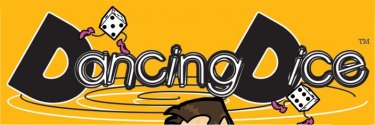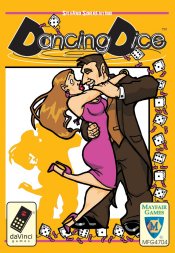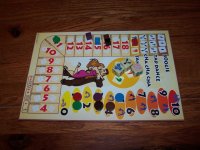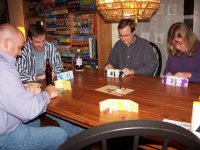
|
Dancing Dice A game by Silvano Sorrentino Published by Mayfair Games, Inc. and da Vinci Games Players: 2-6 Time: 15 minutes Reviewed by Susan Rozmiarek |

|
Dancing Dice is a simple, push-your luck dice game with an unusual theme of ballroom dancers competing in a dancing marathon. Low on strategy, but high on fun, this game is likely to be a hit with the right crowd, in particular casual gamers, in a mixed-gender party setting, and those looking for short, light filler on game nights. Easy enough for an older child, it makes an excellent choice for families as well.
Components:
- 36 dice in 6 sets of different colors. A set of dice contains three dice of the same color with white pips, and white dice with matching colored pips. Each pip on the dice is represented by a footprint.
- Three special Tango dice
- A Black cloth bag to store the dice
- A small game board that depicts a dance scoring track and an endurance track
- Six screens in six different colors
- Six scoring markers in six different colors
- Six endurance markers in six different colors
- Rules in English, Italian, German, and French
Game play:
Each player gets a set of dice, markers and a screen in matching colors. The board is placed in the center of the table and each player places his endurance marker at the top of the track on "10."
Players will be rolling their six dice and arranging them into combinations that will hopefully score them the most points. Players with low scoring combinations will lose endurance points. Once a player loses all his endurance points, he is out of the game. The last dance team (player) left is the winner.
One of the nice things about this game is that the play is simultaneous, so you are never waiting for your turn. Players each take their set of dice and roll them behind their individual screens. They then divide them into two rows of three dice that represent the two dances that they are performing that round. They can re-roll any number of their dice one more time to try to improve their combinations, but they must choose the dice and roll them all at once, not one at a time. The two rows of dice are placed one in front of the other, with one being the first dance performed and the other the second.
Now players remove their screens and each dance is judged. The board has a track that shows the score and dance name for each combination. Most of the dances are scored by adding up the pips on the three die. However, there are numerous special combinations. The top three dances on the track are combinations of all three dice being "ones," "twos,' or "threes," respectively. The fourth highest dance is the Tango. Each round, the set of three Tango dice is rolled and the resulting combination is the requirement for a Tango in this particular round. After that, the next highest dances are all based on the sum of the pips, from eighteen, the Mambo, down to four, the Macarena. Players place their marker on the appropriate spot for their dance combination. The player(s) with the lowest scores must move their endurance markers down one space. The player(s) with the highest score do not move their endurance marker. Tied scores may be broken in favor of "pure" performances, which are combinations that consist of all three dice being either white or all three the solid color. After players have adjusted their endurance markers, the second dance is scored the same way.
There is another special type of dance known as a Rock. This is when a player's two rows are an identical set of numbers to each other. In this case, the player will put his marker on the scoring track as normal for both dances to determine the top scoring dances, but will not have to move his endurance marker down should he score low. This is a very safe combination to put forward, but if it is a low scoring dance, it might allow another player's dance to be in the top scoring group.
The final special type of dance is the Gala. This is when all six of a player's dice show the same number. Again, the player's marker is placed on the scoring track for both dances, but not only does he not have to move his endurance marker down, he gets to move it up two spaces. This is the only way to increase your endurance. In at least ten games, I've never seen this happen!
Discussion:
This light game combines a "push your luck" element with a touch of outguessing your fellow dancers.
The fact that the highest scoring dances are an identical set of the lowest numbers makes it risky to re-roll to try and get those combinations.
If you fail, you might end up with really low scoring dances.
Then you have to try and guess what your opponents are doing and try to put your best dance forward at the right time.
These decisions are not all that tricky or tense, really.
What pushes the game up out of mediocrity for me is its theme.
I haven't seen very many decent dice games with convincing themes. Two of my very favorite dice games, Exxtra and Can't Stop, don't even try. This game, however, has a theme that is not only unusual; it actually feels like it fits. Not only that, the dancing theme and the simple, non-confrontational game play make it an especially appealing choice for families with girls and spouses who don't normally like playing games. It's short enough that it does not become tedious and the simultaneous game play keeps everyone engaged. The game does have one potential problem. Since all the rolling is done behind a screen, it is easy to cheat. Younger players seem to be more susceptible to the temptation.
I've played Dancing Dice about ten times now, with various numbers of from three to six players. The game worked well with all of these numbers of players and though I haven't tried it with two, it would likely work with that number as well. However, given that much of my enjoyment playing the game was due to its social nature, I would definitely recommend it with more, rather than fewer, players. The youngest person I've played the game with is eight years old, and he handled it easily and enjoyed it a lot.
I must admit, after my first game of Dancing Dice, I was not impressed at all. It seemed way too simple and random. The other players, mostly fans of heavier, deeper games, felt the same way. I almost didn't give Dancing Dice a second chance after an unsatisfactory first playing, but fortunately I did, playing with a different group of players. This time the game was much better, with us all laughing and groaning at our bad dancing performances. More playings proved it to be a lot of fun when taken for what it is - a short, light, social game. It is now frequently requested by its fans in my game group when we need a short filler or closer for the evening. This experience reinforces my opinion that a reviewer needs to play a game several times, preferably with different players, before being able to give it a fair review. I could have easily panned this game after one playing, and missed out on a game that is fun with the right group.
| Other Web information: |
This page viewed
E-mail Ed Rozmiarek with questions or problems concerning this page.
Copyright © 2005, Ed & Susan Rozmiarek. No portion of this website may be reproduced or copied without the consent of Ed or Susan Rozmiarek.


